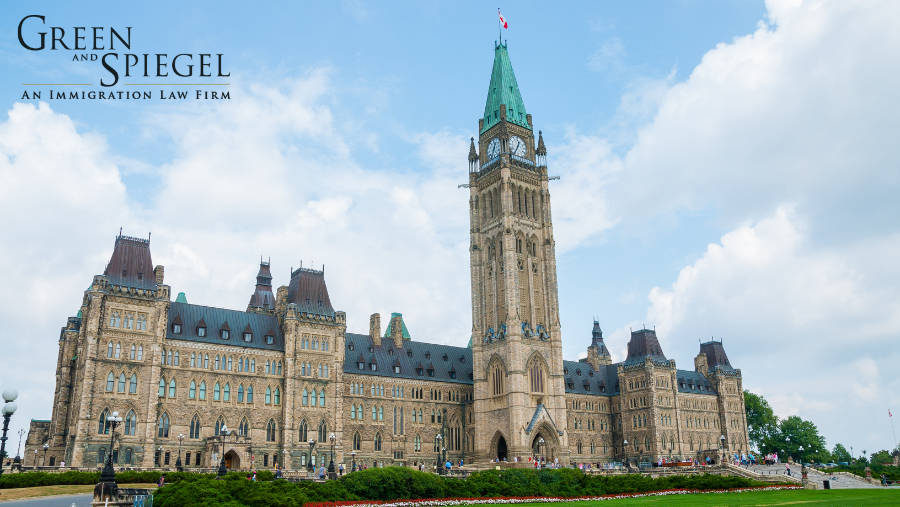What is Canada’s Digital Nomad Policy?
On June 26, 2023, Immigration Refugees and Citizenship Canada (IRCC) released Canada’s Tech Talent Strategy Backgrounder, detailing a strategy to embrace Canada as an emerging leader in global technology talent recruitment. The announcement identifies four key pillars for the strategy, one of which includes the goal of promoting Canada as a destination for digital nomads. A digital nomad is a person who can perform their job remotely for a foreign employer or, in the case of those self-employed, work for themselves or provide services to client(s) outside of Canada.
Practically speaking, the effect of the announcement was not to create a separate application process. Exactly as one would do for travel to Canada as a tourist, applicants can request entry to Canada as a digital nomad at the port of entry (for nationals from visa-exempt countries) or by applying at a consulate in advance of travel to Canada for a Canadian temporary resident visa (“TRV”) (for nationals from visa-required countries). The typical assessment criteria and application process for a visitor entering Canada applies to a digital nomad. Specifically, any foreign national entering Canada seeking to become a temporary resident (e.g. visitor) is required to satisfy either the border official or the IRCC officer at the consulate/embassy abroad that they are a genuine visitor to Canada and will depart Canada at the end of the period authorized for their stay. The policy promoted the fact that Canada is open and willing to approve entry for visitors wishing to stay for six months while maintaining their employment outside of Canada. While visitors in Canada have been legally authorized to do this long before this announcement, the announcement may have made it more likely to receive an approval to enter Canada with this intention, as now processing officers have a reference point when reviewing these requests.
In addition, the same duration of stay applies to standard visitors to Canada and digital nomads. Under the Immigration and Refugee Protection Regulations (“IRPR”), the default period a visitor is granted upon entry to the Country is six months but officers at the port of entry have the discretion to allow a visitor to stay in Canada for less or more than six months by stamping their passport or issuing a Visitor Record identifying a specific date of departure. Following this regulation, IRCC’s policy guidance Temporary residents: Digital nomads released on January 31, 2024 specifies that the duration of entry for a digital nomad is also six months. Importantly, visitors in Canada have the option to submit an application to IRCC to extend their stay in Canada as a visitor beyond the initial expiry date provided they can demonstrate that they continue to be a genuine temporary resident and the circumstances support the grant of an extended period in the country. As digital nomads hold visitor status in Canada, it stands to reason that similarly a digital nomad could seek an extension of their stay in Canada where the circumstances warrant it.
The Canadian Immigration Perspective
The intention of the digital nomad policy appears to be for Canada to position itself as a global hub for tech talent. Although it may, at first glance, be seen as a way for Canada to achieve short-term economic growth —as it allows digital nomads to contribute to the Canadian economy for up to six months during their authorized stay—the language of the Backgrounder appears to position the initiative as attracting highly skilled professionals from around the world to remain in Canada for a longer period:
We expect that some digital nomads who initially enter Canada to work remotely will decide to seek opportunities with Canadian employers. When they receive a job offer from a Canadian company, they would be able to bring their skills to a Canadian employer by applying for a temporary work permit or even permanent residence.
Interestingly, recent shifts in IRCC policy are signalling a restriction on temporary residents in Canada, rather than attracting them. For example, previously digital nomads could also take advantage of Canada’s temporary public policy allowing visitors to apply for work permits from within Canada (i.e. without having to leave the country or apply abroad at a consulate/embassy). This temporary policy was in place until February 28, 2025, however on August 28, 2024 in a surprise announcement, IRCC ended this policy which will have a direct impact on digital nomads who had wished to seek employment and apply for a Work Permit from within Canada.
Practical Considerations: How Can Companies in the US Leverage the Canadian Digital Nomad Policy?
For now, IRCC’s policy on digital nomads in Canada also presents a unique opportunity for companies and workers in the United States.
The L-1 and H-1B visas are two of the most common work visas for foreign workers in the US. The L-1 visa is designed for intra-company transferees, allowing a US employer to transfer an executive, manager, or employee with specialized knowledge, who has worked at the company for at least one year, from one of its affiliated foreign offices to its US office. This visa is particularly useful for companies that are looking to move certain qualifying employees within their global operations into their US branch, parent, subsidiary, or affiliate company. The H-1B visa, on the other hand, allows US employers to hire foreign professionals with specialized skills—particularly those in the fields of technology, engineering, finance, business specialties, architecture, etc.—to work in the US via an unpredictable lottery system. While these visas allow US employers to hire foreign workers to work in the US, both are subject to a maximum authorized stay and renewal limitations, leading to challenges for companies and employees seeking to maintain continuity and retention of skilled talent within their workforce when it comes to visa eligibility and extensions.
1. An Alternative to the H-1B Visa for Those Not Selected Through the H-1B Lottery
On a yearly basis, employers in the United States are desperate to retain talent via the H-1B lottery system. Notably, for many recent college graduates working on their post-grad “Optional Practical Training” (“OPT”) extensions, there simply is no alternative to the long odds that the H-1B lottery provides. Despite entrants regularly numbering in the several hundreds of thousands, the annual H-1B visa limit is 85,000: 65,000 for regular H-1B visas and an additional 20,000 for applicants with advanced degrees. The unfortunate math here is plain to see; because the demand for H-1B visas is so high, the United States Citizenship and Immigration Services’ (“USCIS”) lottery system leaves many qualified employees without an H-1B visa.
However, the Canadian digital nomad policy may offer an alternative to foreign professionals who fail to secure an H-1B visa. Those facing the time crunch of unsuccessful results could potentially take advantage of this digital nomad option, more easily transitioning to working in Canada, enjoying comparable time zones, and being able to continue to more immediately support their employers from a nearby location.
2. An Alternative for Those Who Missed the Canadian Streamlined Work Permit Process for H-1B Holders
Under the same Tech Talent Strategy Backgrounder published on June 26, 2023, IRCC announced that they will be creating a streamlined work permit process for H-1B specialty occupation visa holders in the US to come to Canada. This program, which opened for applications on July 16, 2023, allowed H-1B specialty occupation visa holders in the US to apply for an open work permit of up to three years in duration, which allowed them to work for any employer in Canada; their spouses and dependants could also apply for a TRV (as well as a work or study permit, if applicable). However, this initiative reached its capacity of 10,000 primary applications in less than 48 hours of its launch and has remained closed since.
Foreign professionals in the US (or elsewhere!)—including current H-1B visa holders that did not apply for this Canadian Work Permit stream—who are looking to explore the Canadian labour market and tech sector, could apply to enter Canada as a digital nomad instead. The digital nomad policy gives foreign workers the opportunity to continue their professional careers remotely from in Canada, considering the location, and they can later apply for a work permit if they find a Canadian employer that they would like to work with who would support them. Note however that due to the announcement on August 28, 2024, they can no longer apply for a work permit from within Canada and would be required to leave the country to obtain the work permit.
3. Re-setting Eligibility for an L-1
As noted previously, the L-1 visa requires one year of work experience at a non-US affiliate office. Employees in Canada on non-US payroll via the digital nomad program are accruing time in this regard, achieving the “win-win” in the work authorization world of both accruing time towards this US-based visa, while productively working and immersing themselves in Canada as an alternative, for either the short or long term.
4. Reclaiming time on Existing Visas
Holders of the H-1B, L-1A, and L-1B visas have six-year, seven-year, and five-year maximum periods of stay respectively. As these are maximum periods of stay (which already includes any eligible extensions that such visa-holders received beyond their initial authorized 3-year validity), the L-1 and H-1B visa holders must leave the US once they have reached their maximum period of authorized stay. But what can companies do when their employees’ visas are expiring while the company is going through their crunch time? In such cases, companies may fall into difficult positions because their employees will not be able to continue working in the US.
Interestingly, the digital nomad policy may be helpful in such cases. As foreign workers of these US companies only require visitor status in Canada, these employees can continue to work for the US companies remotely without having to go back to their country of citizenship where there may be dramatic time zone differences. By utilizing the digital nomad option, US companies can maintain core business functions as their employees continue to work for them, albeit remotely, in Canada. This approach could allow businesses to continue operations smoothly, ensuring that key projects and initiatives move forward without substantial disruptions.
The digital nomad policy may also offer a strategic way for employees on L-1 and H-1B visas to potentially extend their legal stay in the US, as time spent outside of the US working (such as time spent in Canada while working remotely for that US company) may be recaptured for their visas. While the L-1 and H-1B visas have a prescribed maximum period of stay, an employer may, in an extension filing before the visa holders reach their maximum period of stay, request that any time an employee has spent time outside of the US—during the validity period of their visas—be recaptured into the maximum period of stay for that employee. This means that if an L-1 or H-1B visa holder spends time abroad, that time can be “recaptured” and used to extend their stay in the US once they return. In effect, such visa holders can extend the time to legally work and reside in the US under their H-1B or L-1 status. However, to take advantage of the recapture policy, visa holders must document the time that they have spent outside the US with evidence.
For additional insights into Canada’s Digital Nomad Policy and how it may affect you, please contact us.








